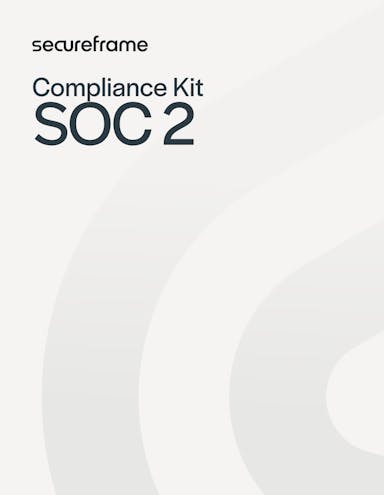
SOC 2 Compliance Checklist for 2026: How to Prepare for a Successful SOC 2 Audit
Emily Bonnie
Senior Content Marketing Manager
Fortuna Gyeltsen
Senior Manager, Compliance and Product (Automation)
Getting a SOC 2 report is an important step for any service organization. But getting compliant for the first time can be confusing and time-consuming. How do you know when you’re ready for an audit?
After all, there’s no one-size-fits-all approach, and SOC 2 compliance requirements can vary.
But that doesn’t mean you can’t go into an audit with confidence. In this article, we’ll explain how to prepare for a SOC 2 audit, and share an interactive SOC 2 audit checklist to help you gauge your audit readiness and plan your compliance journey.
SOC 2® in 2026: Why it still matters
SOC 2 has become a baseline security compliance expectation for cloud providers, SaaS platforms, and other service organizations that store or process customer data. Even in industries with specific regulations like HIPAA, PCI, or SOX, customers increasingly expect a SOC 2 audit report as proof that your security controls and security practices hold up under independent review.
Buyers use SOC 2 not just to assess security, but to compare vendors on reliability, privacy, and overall risk mitigation. For many growing startups, that means a SOC 2 compliance audit is now a prerequisite to winning larger deals and working with more mature enterprise stakeholders.
An introduction to SOC 2®
SOC 2 stands for Service Organization Controls 2. It’s an attestation report created by the American Institute of Certified Public Accountants (AICPA) that’s designed to help build trust between service organizations and their customers by evaluating whether your controls meet specific SOC 2 compliance standards.
SOC 2 compares a service organization’s security controls against five Trust Services Criteria:
- Security: How you secure data against unauthorized access
- Availability: How available and accessible your services are to users
- Confidentiality: How you protect confidential information from a data breach
- Processing integrity: How you ensure data is processed in a timely, accurate manner
- Privacy: How you keep user and customer data anonymous and protected
These are sometimes referred to as the “trust service principles,” and together they paint a picture of how well your organization protects systems, data, and users.
We’ll cover these Trust Services Criteria a bit more in-depth later, but first, let’s answer a crucial question.
Why does your organization need a SOC 2® report?
SOC 2 compliance is not mandatory or legally required. However, if you’re a service organization that directly affects users’ operational efficiency (e.g., cloud service provider, SaaS, data center, etc.) and you store customer data such as PII or other sensitive records, you probably need to become SOC 2 compliant.
Why?
It’s likely that prospects and customers will request a SOC 2 report during vendor selection or for their own auditing processes. Not providing this report may stall sales cycles, affect credibility with customers, and hinder your ability to move upmarket. Many security and procurement teams also use your SOC 2 audit report as a shortcut to complete their internal vendor risk questionnaire, which can dramatically speed up evaluation.
A SOC 2 audit will also help you better understand the current performance of your security controls and spot potential gaps. You’ll be able to identify vulnerabilities, keep your organization safe, and build more efficient business processes.
Some of the main benefits of SOC 2 compliance include:
- Build stronger client relationships: Committing to SOC 2 compliance proves to prospects, customers, and partners that you care about the security and integrity of their data and have documented security policies and procedures in place.
- Prevent security incidents: A SOC 2 report will help you meet the highest security standards to avoid a data breach.
- Get valuable information about your business: Completing a SOC 2 audit will help you build a stronger security posture and give you valuable insights into the overall design and performance of your security controls. You will also gain clearer visibility into access control, logging, firewalls, and other technical controls that support ongoing data security.
Recommended reading

Why Get a SOC 2 Report? 13 Reasons According to Real Organizations
Who conducts a SOC 2® audit?
SOC 2 examinations are attestation audits, which means an external, third-party auditor will assess your security controls and issue a final report about how well they meet SOC 2 requirements.
This report typically includes:
- Audit summary: A summary of the audit scope, time period, and auditor’s final opinion regarding the organization’s level of SOC 2 compliance.
- Management assertion: Organization leadership explains the systems and internal controls that are under audit.
- System description: A detailed overview of the system under audit, including system components, procedures, and incidents.
- Control tests: A description of the tests performed during the audit and the results.
Keep in mind; SOC 2 examinations are governed by the AICPA and must be performed by a licensed and accredited CPA firm. The auditing firm must also be completely independent from the organization that’s undergoing the audit to maintain objectivity.
Unlike SOC 1 reports, which focus on controls that impact customers’ financial reporting, SOC 2 is focused on information security, privacy, and data protection. Many organizations now pair SOC 2 with other frameworks and regulations, including SOC 1, PCI, and HIPAA, depending on their industry and customer requirements.
For more information on the who, what, and why of SOC 2, check out the video below from our compliance expert Chris Sesi or keep reading to dive into the readiness process.
5-Step guide to SOC 2® audit prep
Preparing for a SOC 2 audit without any guidance is like navigating a jungle without a map.
To help you stay on track and avoid common pitfalls, we’ve put together a list of 35+ questions to prepare for a SOC 2 audit.
This step-by-step guide will break down the entire process. Let’s get into it!
Step 1: Choose your SOC 2® report type
First, you need to understand the different types of SOC 2 reports to decide what you need right now.
There are two types of SOC 2 reports: Type I and Type II.
SOC 2 Type I reports assess your organization’s controls at a single point in time. It answers the question: are your internal controls designed in a way that meets SOC 2 requirements?
SOC 2 Type II reports evaluate the performance of your controls over a longer period of time, typically 6-12 months, but can be as little as 3 months. When people ask for “a full SOC 2,” they usually mean a SOC 2 Type 2 report that shows how your controls operated over that review period.
How do you decide which report type you need? Ask yourself:
- Which report type are your customers asking for? While some may accept a Type I report, most require a Type II.
- How urgently do you need a SOC 2 report? Type I audits are faster to complete and can satisfy customers while you pursue a Type II report.
- Do you have the resources to complete multiple audits? Some customers will accept a Type I report in the interim as you prepare for a Type II audit. If you opt to go straight for a Type II report, you will only need to complete one annual audit, rather than both a Type I and a Type II.
If you are an early stage company, a SOC 2 Type 1 can help you prove that your control design is sound while you collect operating evidence for your first SOC 2 Type 2 report. More mature organizations usually move directly to recurring SOC 2 Type 2 audits.
Step 2: Select your Trust Services Criteria
As we stated earlier, SOC 2 audits assess your security controls against five Trust Services Criteria defined by the AICPA:
- Security
- Availability
- Processing integrity
- Confidentiality
- Privacy
Security is the only TSC that’s required for every audit. That’s why it’s often referred to as the “common criteria.” The other four TSC are optional. You’ll need to decide which other TSC to include (if any) based on customer demands and specific industry regulations.
For example, a cloud service provider might need to include the availability and security principles, while a payment processor system may need to include processing integrity and privacy. Healthcare organizations that already follow HIPAA may prioritize privacy and confidentiality to show how their security measures align with existing regulations.
That said, we share some helpful questions for each principle below.
Security
Security is the only required principle by the AICPA, so you must pay special attention to the security controls you have in place to protect users’ sensitive information from unauthorized access.
- What are you doing to monitor and prevent cyber attacks and data breaches?
- Do you have specific procedures to monitor and respond to security incidents?
- Are your devices and applications updated on a regular basis?
- How do you handle vulnerabilities within your systems?
- Do you have defined backup and recovery procedures in place?
- Have you tested and documented your security procedures?
- Do you have defined access controls in place?
This is also where you document key security policies, such as an acceptable use policy, access control policy, and change management process, and show how you enforce those policies in practice.
Availability
Availability refers to how accessible your system is for user operations. Often companies that need to be available and ready at all times for their customers will include availability within their scope. For example, if you offer payroll management services to large manufacturing companies, you must ensure that your system is available whenever your clients need it.
Some helpful questions may include:
- Are your services available at all times?
- Are your services restricted to certain users?
- Do you have business continuity plans in place? How do you handle service issues that could affect your availability?
Strong availability controls often include a documented incident response plan, tested disaster recovery plans, and clear communication processes for internal and external stakeholders.
Processing integrity
Processing integrity aims to help service users protect the integrity of their information. Companies that process a lot of data, and/or have a lot of integrations, such as Secureframe, will include processing integrity in the scope of their SOC 2. For example, if you offer a payment gateway service, your system must process customer data quickly, securely, and accurately.
- Are your processing systems working reliably?
- Are your processing systems providing timely, accurate data to users?
- How do you handle system failures and issues?
- Do you have specific procedures in place to correct errors quickly?
If your product integrates with other systems, this is also where you document how you validate data quality, handle failures in downstream services, and test new or updated functionality before release.
Confidentiality
If you’re handling confidential customer information or helping customers manage their users’ sensitive information, ask yourself.
- How are you handling and processing data to ensure confidentiality?
- Is data protected and classified at all times?
- Do you have strict access controls in place to avoid unauthorized access?
Confidentiality controls are especially important if you store source code, contracts, internal business data, or other confidential documents that customers expect you to safeguard.
Privacy
Privacy refers to the protection and anonymity of user information. If your company has a lot of sensitive information you may want to include privacy in your scope. Here are some helpful questions:
- Do you have a data retention policy in place?
- How and where do you classify, process, and store personal data?
- What controls are in place to protect personal data?
Privacy controls often overlap with data security, but they focus specifically on how you collect, use, retain, and delete personal information, including PII, across your systems and workflows.
Step 3: Set your audit scope
Define the systems and controls you want to include in your audit and define why they matter from the user’s perspective. If you’re pursuing a Type II report, you’ll also need to set an audit window.
- What’s the system in scope? (I.e., specific applications or databases, office locations, departments, etc.)
- For SOC 2 Type II, what’s the audit window? A typical audit window is 6-12 months, but it’s possible to set a shorter, 3-month audit window. A longer audit window requires longer to be in compliance and more evidence to provide, however it also carries more weight than a 3-month report.
At this stage, many organizations also decide whether to limit the scope to a specific product or environment, such as production systems only, or include supporting services like customer support tools and internal admin functionality.
Recommended reading

How to Define Your SOC 2 Audit Scope
Step 4: Design and implement security controls
Once you have defined the scope of your report, it’s time to identify risks and describe the actual controls you’re going to test.
- Do you understand the risks associated with your information assets and systems?
- Have you identified the likelihood and potential impact of these risks on your organization?
- Do you have a risk treatment plan in place to accept or mitigate risks?
- How often do you perform risk assessments to identify changes in your threat landscape?
- How do you document and maintain internal controls to mitigate organizational risk?
- Do you have an access control policy in place to define who can access data and when?
- Do you maintain access logs to monitor activity and flag anomalies?
- Do any security controls rely on any third-party software? If so, what steps have you taken to manage vendor risk?
Effective SOC 2 controls typically cover data security, secure software development, change management, logging and monitoring, employee and vendor onboarding and offboarding, and regular training on security policies. The more clearly you document these security measures and how they operate, the easier your audit experience will be.
Step 5: Conduct a gap analysis and readiness assessment
A gap analysis can identify any weaknesses in your controls that could affect the outcome of your audit.
The most efficient way to run a gap analysis is with an automated compliance tool, which can check all of your systems and controls against SOC 2 criteria to immediately flag any misconfigurations or gaps in your compliance posture. Modern platforms like Secureframe use automation and continuous monitoring to test your controls, surface issues early, and provide targeted risk mitigation guidance.
Secureframe customers can also use Comply AI to generate and refine policies, and AI Evidence Validation to automatically review uploaded evidence for relevance, timing, and completeness before it ever reaches your auditor. This significantly reduces rework and helps you walk into your audit with a clean, well-documented audit trail.
If you don’t opt for an automated tool, your internal compliance or information security team can manually check your controls to ensure compliance before your auditor begins their examination.
A readiness assessment is an examination performed by the auditor to determine how prepared your organization is for a SOC 2 examination. This will help you better understand the current state of your organization’s controls.
A gap analysis and readiness assessment help you answer:
- Is your organization ready for a SOC 2 examination?
- Are your current controls sufficient to satisfy compliance requirements?
- Are there any gaps you need to fix prior to your SOC 2 examination?
Some organizations also use the readiness phase to complete internal questionnaires, run tabletop exercises, and align stakeholders from security, engineering, and leadership on the overall plan and timelines.
Recommended reading

4 Steps to Conducting a SOC 2 Self-Assessment + Free Readiness Checklist
Use this SOC 2 audit checklist as a high-level guide to the steps you should complete before scheduling your audit.
SOC 2 Compliance Checklist
Scope Your SOC 2 Audit
Design and Implement Controls
Conduct a Gap Analysis and Readiness Assessment
Evaluate and Select a SOC 2 Audit Firm
If you are preparing for your first SOC 2 audit, pairing this checklist with a structured SOC 2 readiness assessment will help you avoid last-minute fire drills, support stronger security compliance, and give your customers confidence in how you protect their data.
Everything you need to prepare for your SOC 2® audit
SOC 2 compliance may be exhaustive, but it doesn’t have to be exhausting. We’ve created a library of resources to demystify and simplify SOC 2:
- SOC 2 Compliance Hub: 35+ articles and resources that cover everything you need to know about SOC 2 audits.
- Expert advice and best practices: Our former auditors and compliance experts share their tips and answer common questions.
- Automated compliance: Continuous monitoring and evidence collection, vendor and personnel management, risk management, compliance dashboards, and much more to simplify and streamline SOC 2.
- SOC 2 Compliance Kit: Free policy templates, compliance checklists, and evidence spreadsheets to save you hours of manual work.

SOC 2 Compliance Kit
Get key assets you’ll need to get your SOC 2 report, including a compliance guidebook, customizable policy templates, readiness checklist, and more.
FAQs
What is SOC compliance checklist?
A SOC 2 compliance checklist is a tool designed to help an organization evaluate its compliance with the SOC 2 framework and ensure it has completed the essential steps to prepare for a successful audit. Using the checklist, organizations can check off the boxes to visualize their level of audit readiness and quickly identify any gaps they need to remediate before undergoing an audit. Many teams also use a checklist as an internal questionnaire to confirm that policies, controls, and evidence are in place for each Trust Services Criteria in scope.
How do I check my SOC 2 compliance?
In addition to using a checklist to check your SOC 2 compliance, you can undergo a SOC 2 self-assessment or SOC 2 readiness assessment During a SOC 2 self-assessment, an organization maps existing information security controls and policies to their selected TSC, identifies any gaps, and creates a remediation plan ahead of their formal SOC 2 audit. A readiness assessment is similar except it's conducted by an auditor accredited by the American Institute of Certified Public Accountants (AICPA). Automated tools like Secureframe can streamline this process by continuously testing controls, validating evidence, and surfacing any gaps before your auditor does.
Who is responsible for SOC 2 compliance?
An organization may have a dedicated compliance team or individual that's responsible for SOC 2 compliance. This team or individual will work with the engineering team to ensure the technical controls are in place and the HR team to ensure the administrative controls are in place to achieve and maintain SOC 2 compliance. However, it's important that everyone at your organization understands their role and responsibilities in keeping your organization secure and compliant. Clear ownership, documented workflows, and strong coordination between stakeholders are essential to maintaining SOC 2 controls over time and supporting ongoing cybersecurity efforts beyond a single audit.

Emily Bonnie
Senior Content Marketing Manager
Emily Bonnie is a seasoned digital marketing strategist with over ten years of experience creating content that attracts, engages, and converts for leading SaaS companies. At Secureframe, she helps demystify complex governance, risk, and compliance (GRC) topics, turning technical frameworks and regulations into accessible, actionable guidance. Her work aims to empower organizations of all sizes to strengthen their security posture, streamline compliance, and build lasting trust with customers.

Fortuna Gyeltsen
Senior Manager, Compliance and Product (Automation)
Fortuna Gyeltsen is a former auditor and security consultant with nearly fifteen years of experience in security, privacy, and compliance. As a consultant for Blue Canopy and Coalfire, she developed deep expertise in FISMA, ISO 27001, SOC 2, PCI DSS, BSI C5, and DoD IL 4 and 5. At Secureframe, she worked as a Senior Manager of Compliance and now of Product to help customers automate more of the compliance process so they can focus on big picture improvements rather than shallow work.